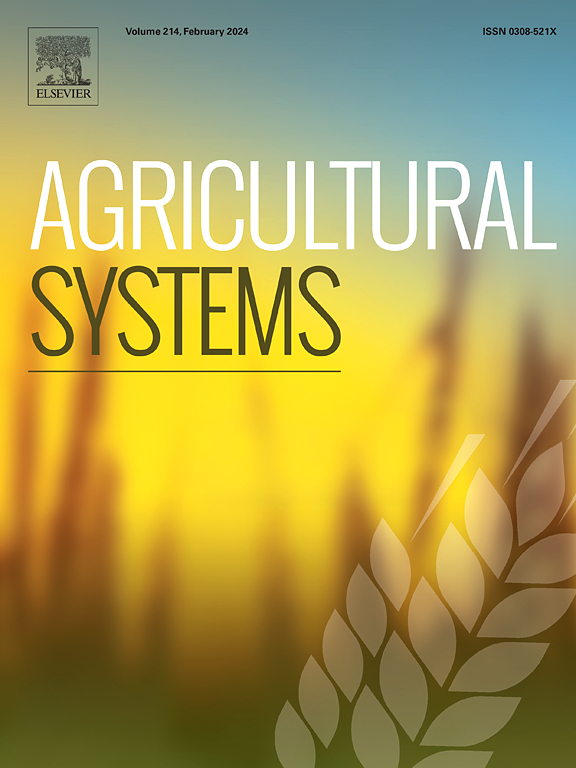The potential to increase maize yields and mitigate climate change by adopting integrated soil fertility management across different regions in Kenya — A simulation study
IF 6.1
1区 农林科学
Q1 AGRICULTURE, MULTIDISCIPLINARY
引用次数: 0
Abstract
Context:
To avoid soil fertility decline and increased greenhouse gas (GHG) emissions, it has been recommended to improve maize yields in sub-Saharan Africa with sustainable practices such as Integrated Soil Fertility Management (ISFM), instead of relying solely on mineral fertilizer. However, the yield responses and environmental trade-offs of ISFM likely depend on soil and climatic conditions.
Objective:
To explore this, we used the DayCent model to simulate 30-year average yields of maize monoculture across Kenya under 17 different ISFM scenarios, co-created with Kenyan smallholder farmers. We compared yields, changes in SOC stocks and N2O emissions against current baseline conditions (monocropping with minimal nutrient inputs).
Methods:
The scenario that best represented a ’feasible-input’ level consisted of 2 t C ha−1 yr−1 of farmyard manure and 60 kg N ha−1 season−1 of mineral fertilizer. Other scenarios included different amounts (0, 1, and 2 t C ha−1 yr−1) and types of organic inputs in combination with four rates of mineral N fertilizer (0, 30, 60, and 90 kg N ha−1 season−1). The uncertainty of model predictions was quantified through Monte Carlo simulations.
Results and Conclusions:
The model results indicate a significant potential for yield improvements in the humid regions of western Kenya (from 3.7 to 8.1 t ha−1 yr−1) with the ‘feasible-input’ compared to the baseline scenario; GHG emissions per kg of yield were generally lower (the median value reduced from 0.9 to 0.5 kg CO2-eq kg−1 yield). However, in the semi-arid regions of eastern Kenya, maximum yields under any scenario were 1.1 t ha−1 yr−1, reached at inputs of 1 t C farmyard manure ha−1 yr−1 or 60 kg mineral N ha−1 season−1. The uncertainty analysis showed a high confidence in the ‘feasible-input’ scenario’s ability to increase yields and reduce SOC losses compared to the baseline, but a high uncertainty regarding its impact on GHG emissions. Specifically, the 95% credibility intervals for the combined CO2 and N2O emissions ranged from reductions of up to 1000 kg CO2-eq ha−1 yr−1 to increases of up to 200 kg CO2-eq ha−1 yr−1.
Significance:
These results strongly support the use of ISFM practices to enhance maize yields and mitigate soil fertility losses, particularly in areas with sufficient rainfall. However, due to the high uncertainty surrounding simulated N2O emissions, we cannot establish with certainty whether ISFM reduces GHG emissions on a per hectare basis or increases them.

通过在肯尼亚不同地区采用综合土壤肥力管理提高玉米产量和减缓气候变化的潜力——一项模拟研究
背景:为了避免土壤肥力下降和温室气体(GHG)排放增加,建议在撒哈拉以南非洲地区采用诸如综合土壤肥力管理(ISFM)等可持续做法来提高玉米产量,而不是仅仅依赖矿物肥料。然而,ISFM的产量响应和环境权衡可能取决于土壤和气候条件。为了探讨这一点,我们使用DayCent模型模拟了肯尼亚17种不同ISFM情景下玉米单一栽培的30年平均产量,这些情景是与肯尼亚小农共同创建的。我们将产量、有机碳储量和N2O排放的变化与当前基线条件(最小养分投入的单作)进行了比较。方法:最能代表“可行投入”水平的方案包括:2吨C公顷- 1年- 1农家肥和60公斤N公顷- 1季- 1矿物肥。其他方案包括不同的有机投入量(0、1和2吨公顷- 1年- 1)和有机投入类型,以及四种氮肥水平(0、30、60和90公斤氮肥- 1季- 1)。通过蒙特卡罗模拟对模型预测的不确定性进行了量化。结果和结论:模型结果表明,与基线情景相比,在“可行投入”的情况下,肯尼亚西部潮湿地区的产量有显著提高的潜力(从3.7吨/年- 1年- 1增加到8.1吨/年- 1);每公斤产量的温室气体排放量普遍较低(中位数从0.9公斤二氧化碳当量每公斤- 1产量减少到0.5公斤二氧化碳当量)。然而,在肯尼亚东部的半干旱地区,在任何情况下的最高产量均为1.1吨/公顷- 1年- 1,在投入1吨农家肥- 1年- 1或60公斤矿物氮- 1季- 1时达到。不确定性分析表明,与基线相比,“可行投入”方案提高产量和减少有机碳损失的能力具有很高的可信度,但其对温室气体排放的影响具有很高的不确定性。具体来说,CO2和N2O联合排放的95%可信区间从减少高达1000 kg CO2当量ha−1年至增加高达200 kg CO2当量ha−1年至1年。意义:这些结果有力地支持使用ISFM实践来提高玉米产量和减轻土壤肥力损失,特别是在降雨充足的地区。然而,由于模拟N2O排放的高度不确定性,我们无法确定ISFM是在每公顷的基础上减少还是增加温室气体排放。
本文章由计算机程序翻译,如有差异,请以英文原文为准。
求助全文
约1分钟内获得全文
求助全文
来源期刊

Agricultural Systems
农林科学-农业综合
CiteScore
13.30
自引率
7.60%
发文量
174
审稿时长
30 days
期刊介绍:
Agricultural Systems is an international journal that deals with interactions - among the components of agricultural systems, among hierarchical levels of agricultural systems, between agricultural and other land use systems, and between agricultural systems and their natural, social and economic environments.
The scope includes the development and application of systems analysis methodologies in the following areas:
Systems approaches in the sustainable intensification of agriculture; pathways for sustainable intensification; crop-livestock integration; farm-level resource allocation; quantification of benefits and trade-offs at farm to landscape levels; integrative, participatory and dynamic modelling approaches for qualitative and quantitative assessments of agricultural systems and decision making;
The interactions between agricultural and non-agricultural landscapes; the multiple services of agricultural systems; food security and the environment;
Global change and adaptation science; transformational adaptations as driven by changes in climate, policy, values and attitudes influencing the design of farming systems;
Development and application of farming systems design tools and methods for impact, scenario and case study analysis; managing the complexities of dynamic agricultural systems; innovation systems and multi stakeholder arrangements that support or promote change and (or) inform policy decisions.
 求助内容:
求助内容: 应助结果提醒方式:
应助结果提醒方式:


